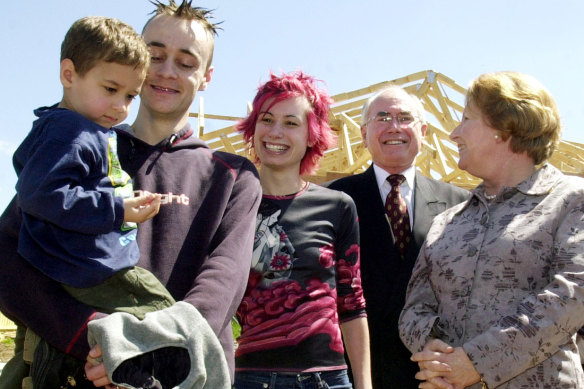Locked out of home ownership? Thank John Howard and the seat of Aston
John Howard had his back against the wall as an awkward byelection came at him in the seat of Aston, in Melbourne’s eastern suburbs.
But Howard being Howard, he had a weapon up his sleeve.

He’d experienced a vision among the newly tiled roofs spreading across the suburbs.
Out there, he felt, lay hope in the Australian Dream. And votes. He would supercharge the dream and harness the votes of all those young people wanting to get into their first home.
Twenty-two years later, as the voters of Aston go to the ballot box for this weekend’s April Fool’s Day byelection, it is possible to trace the beginnings of today’s preposterous housing market – so massively inflated it all but locks out a generation of would-be first home buyers – to Howard’s desperate vision.
It was mid-2001 and just about everything that could go wrong had gone pear-shaped for Howard and his government. His GST had been introduced the previous year, to much howling.
In the first half of the year uproar spread across the land about petrol prices, small businesses flummoxed by GST red tape, and even the price of beer.
Both the West Australian and Queensland Liberal governments were given the heave-ho in state elections in February. Howard and his GST copped a lot of the blame.
In March, Labor won a byelection in the Brisbane seat of Ryan, previously considered a blue-riband Liberal electorate.
Howard spent months turning himself inside-out trying to fix his problems, even cutting the fuel excise tax and announcing a “temporary” pause in indexing it to inflation, which took 15 years to reverse.
Howard was in a hurry: he was due to face a general election in the second half of the year, and polls suggested he was losing to Kim Beazley’s opposition. A byelection in Aston caused by the death of long-time Liberal MP Peter Nugent shaped as a grim prospect.
But Howard had seen a future rooted in the past among those red-tiled rooftops rising across the nation’s suburbs. His hero, Robert Menzies, had overseen a nation with 70 per cent home ownership. Howard would try to do even better.
In 2000, Howard had introduced a $7000 first homeowners’ grant scheme as compensation for the introduction of the GST. It proved instantly popular.
Suddenly, on March 23, 2001 – precisely six days after the disastrous Ryan byelection – Howard’s government announced it was doubling the First Home Owners Grant to a mighty $14,000.
Ostensibly, the purpose was to provide “a targeted, short-term stimulus to the building sector”.
It seemed curious: builders were entitled to optimism because interest rates were falling. The average mortgage rate in 2001 was 6.97 per cent, down from 8.05 per cent in 2000.
It would fall in the next two years to 5.8 per cent and settle around there until 2009-2010, when it began its decade-long plunge to the historic lows of the pandemic.
The $14,000 handout was a political ploy. The stimulus, clearly, was for mostly young families to deliver their thanks in votes.
The $14,000 was available only to those who entered contracts between March and December 31, 2001, to build or purchase new homes. In short, the extra joy was available only during the 2001 election period.
It was embraced gleefully. In 2001-2002, first home buyers represented almost a quarter of all financed home purchases in Australia.
Mortgageville Aston, instead of turning its back on Howard’s government, as previously expected, elected Liberal candidate Chris Pearce.
The next day, Howard declared : “I believe that the government is well and truly back in the game. If there were an unstoppable momentum for Labor to win the federal election, they’d have rolled us over in Aston.”
Howard always maintained that after Aston he believed he’d win against Beazley – as he did – and that it was suburban Australia, not the fear engendered a few months later when hijacked jets smashed into the Twin Towers in New York, nor his own appeal to xenophobia when the MV Tampa, laden with asylum seekers, sailed to Christmas Island – that saved him.
There was, as ever, a cost. From July 2000 to June 2002, around 360,200 grants were made, totalling almost $3 billion.
The bigger cost was to the future.
With all that extra cash injected into the housing market, and interest rates falling, house prices began rising from 2001 and never stopped. With every state competing with various schemes, the cash kept coming, prompting further runaway housing prices.
In 2008, responding to the global financial crisis, Kevin Rudd’s government tripled the grants for new homes to $21,000 and doubled handouts for existing houses to $14,000.
Two years ago, a study by the Australian Housing and Urban Research Institute found that Australian governments had spent more than $20.5 billion on first home buyer schemes in the previous decade.
And what of the supposed benefits of those massive handouts to first home buyers?
It had made housing affordability worse by driving up property prices and leaving existing homeowners richer, the study found.
Quite. Analysis of census data by the bureau of statistics in 2022 showed home ownership for those aged between 25 and 39 had decreased in each successive generation since the 1990s.
At least in part, we can thank John Howard and a byelection in Aston.
Most Viewed in Business
Source: Thanks smh.com